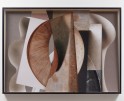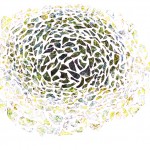Xuan-Hui Ng In Coversation with Christophe Potworowski
“The recent conflict in Ukraine has shaken me deeply due to my family roots being in Eastern Europe. Feelings of helplessness, loss, alienation, and meaninglessness were rampant. This caused me to re-examine the foundations underlying my relationships and belief systems, which no longer felt reliable. In the midst of my soul storm, I have a longing for authentic expression and, ultimately, for new meaning. Through the use of multiple exposure, montage, and camera movement, my images explore some of these experiences as internal and metaphorical realities.” Christophe Potworowski
Christophe Potworowski’s interest in photography began as a teenager when his brother gave him an Agfa folding box camera. He enjoyed being able to respond spontaneously to the world around him. Soon, he was hooked by the problem solving involved in making images and especially by the fact that the process involved both rational and emotional dimensions.
Living near Vancouver, in Canada’s British Columbia, and attracted by interpretive and abstract image-making rather than representative photography, he strives to look for a deeper meaning emerging from the relations between color and the other elements of design. After years of working in a scholarly setting, he now looks for beauty in more concrete ways.
In 2022, a solo exhibition of “SoulStorm” was held at The Heart of Edson gallery in Alberta, Canada. In the same year, he participated in group shows at the South East Center for Photography (“Abstract”) in North Carolina, and at the ASmith Gallery (“Trees”) in Texas.
Instagram @christophepotworowski
Could you tell us why the Ukraine–Russia war affected you so much even though you are so far away in Canada?
My family is Polish. My mother comes from the area near Lwów, which is now called Lviv in western Ukraine. Although I no longer have family in Ukraine, I have close family living in Poland, near the border. In the past, my family suffered at the hands of the Soviet Communists so the Ukraine–Russia war feels very personal.
On February 22, 2022, when Russia invaded Ukraine, I had an emotional reaction that approximated a “traumatic” experience. I have qualms about calling it “traumatic” because I was not present at the bombings. However, the war turned my world upside down and shook me to the core. I experienced a loss of meaning. Every time the topic of the war came up, I found myself paralyzed and unable to talk about it.
What inspired you to work on this project?
After the war started, people posted works of art in Ukrainian colors and/or with Ukrainian motives to show their support for Ukraine. I was inspired by that and wanted to do something similar. This project allowed me to scream out my helplessness.
Could you share with us your philosophical approach to photography?
Although I consider myself a realist, albeit probably not in the usual sense of the term, I find documentary photography too restrictive to express the reality I see. Abstract and expressive photography, by way of multiple exposure, montage and camera movement, allows me to seek and find deeper meaning.
Wonder has been always fundamental to me. I like to get lost in beauty. I am often moved by what other artists can express through music, painting, photography, and art. They go beyond the utilitarian approach to life.
I am keenly aware that I am not in complete control of my own destiny. I am shaped by my religious upbringing and academic background in theology. My art allows me to connect with the spiritual side of life without any scholarly apparatus and in a more personal way.
Who are some of the artists you admire?
Glenn Gould, Charlie Mingus, Mark Rothko, Georges Rouault, Marc Chagall, Franz Marc, Emil Nolde.
Your images are so intricate. I feel it’s easy to miss the significance of these details and would appreciate it if you could help us navigate through some of your images.
There are four images I would like to talk about. I am reluctant to ascribe any definitive meanings to symbols as I feel they are alive and, rather than me choosing them, they chose me.
“In the East” is the first image in the “SoulStorm” series. The base layer here is the image of a ferry terminal. I use it to convey a sense of chaos. Although the colors are reminiscent of the Ukrainian flag, my intention was not primarily or explicitly political. It just felt right and came to be.
In “Shapes of Life,” the oval shapes are like eggs. In the Eastern Orthodox tradition, eggs symbolize new life. The dark colors surrounding these oval shapes depict new life being hampered by darkness.
In “Blue Portal,” I chose a church as the base layer. It is an important element. Religion was and still is an explicit part of the conflict. I want to show the role of the church in the midst of the conflict. The beauty of the flowers exists in contradiction with the war. The almost unnoticeable red marks refer to blood and a reminder of the ever-present suffering.
In “Picking up the Pieces,” I want to honor the survivors who have to deal with the destruction. I inserted a red line because it felt right but I couldn’t and still can’t quite explain why I did that. I feel that something would be amiss without the red line.
Has working on this project helped you resolve some of the internal turmoil you felt?
The project has given me the opportunity to express my feelings and to break out of a certain isolation and paralysis. The meaning I found doesn’t protect me from reality. It is fragile but quietly hopeful.
Thank you to Xuan-Hui Ng
Follow on instagram: @xuanhui_ng
Posts on Lenscratch may not be reproduced without the permission of the Lenscratch staff and the photographer.
Recommended
-
Photography Educator: Erin Ryan StellingJanuary 9th, 2026
-
The Female Gaze: Alysia Macaulay – Forms Uniquely Her OwnDecember 17th, 2025
-
Bill Armstrong: All A Blur: Photographs from the Infinity SeriesNovember 17th, 2025
-
Robert Rauschenberg at Gemini G.E.LOctober 18th, 2025
-
Erin Shirreff: Permanent DraftsAugust 24th, 2025




































































